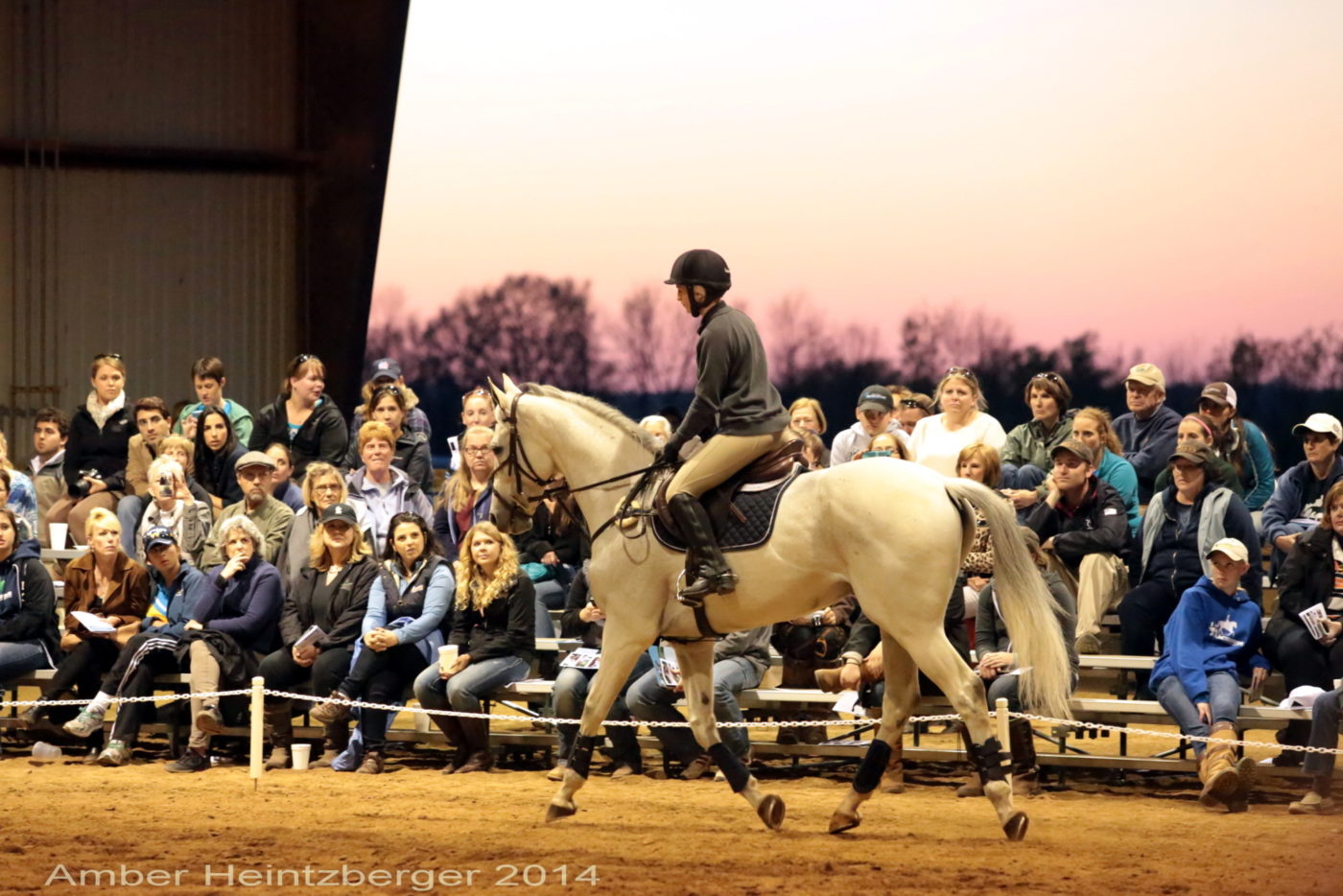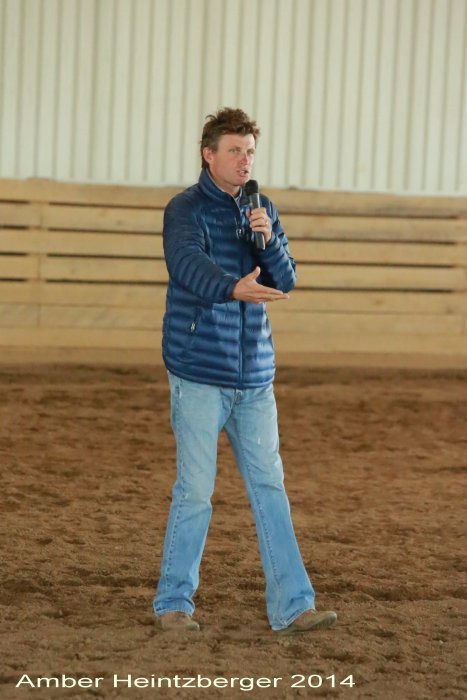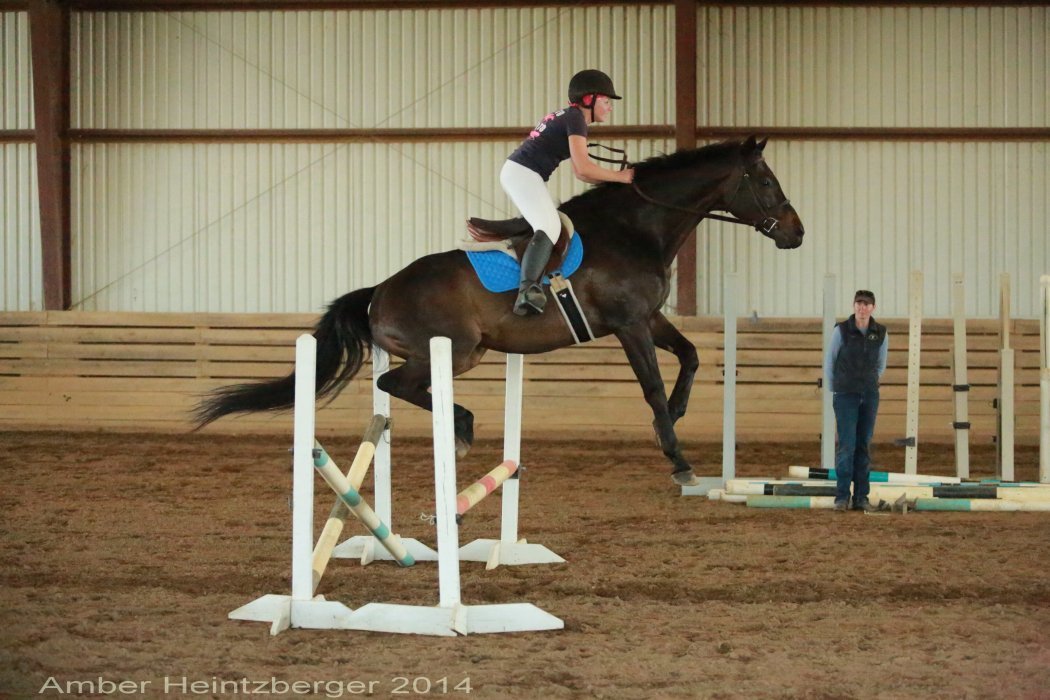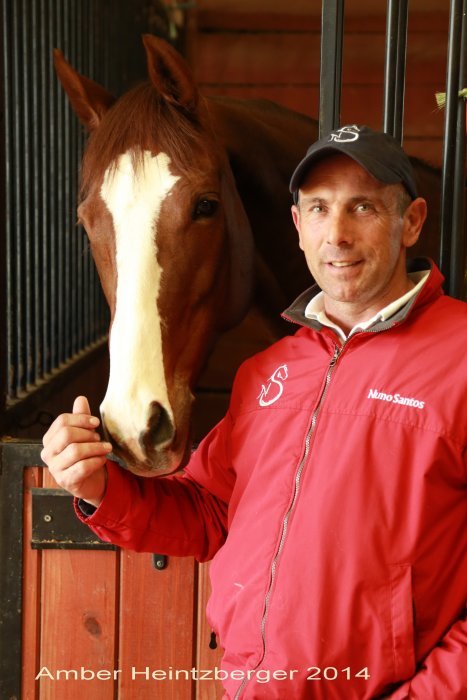

In the midst of the Rolex Kentucky Three-Day Event, New Vocations Racehorse Adoption and the Retired Racehorse Training Project showcased off-the-track-Thoroughbreds (OTTB) with the The Thoroughbreds For All presentation, held at New Vocations’ Lexington facility at West Wind Farm. The event featured dinner, an open bar and a packed house.
Things kicked off with a welcome to Rolex riders competing on OTTBs, and continued with an in-hand presentation of New Vocations prospects with commentary and evaluations from New Vocations Director Anna Ford, communications professional Jenn Roytz, dressage judge Linda Zang and eventer Boyd Martin. Then came demonstrations by Nuno Santos on third level dressage horse Ken’s Kitten, Cathy Wieschhoff on Morgan Garrett’s talented young event horse Action Now, Lynn Symansky on her top three-day horse Donner, and jockey Rosie Napravnik on her own horse Sugar. Trainer Steuart Pittman, founder and president of the Retired Racehorse Training Project, commented throughout the evening.
Canadian Marissa Hishon pointed out that Canada doesn’t have organizations that specialize in the retraining of ex-racehorses.
“Unless you’re very experienced [at selecting horses that are still on the track], it’s hard to know what you’re looking at and what they’ll be like after they’ve been let down,” she said.

In watching the prospects, Boyd Martin commented that he would likely be looking for a different type of animal than the average rider. For a four-star horse, he wants something with excellent conformation with an extreme level of athleticism. He liked the first horse in the ring, Dave in Dixie, a nearly 17-hand 2007 gelding by Dixie Union, for himself. But for an amateur, he noted that the second horse in the ring, Rein King, looked more appropriate.
“I think this looks like a good amateur horse; he’s quiet, friendly and easygoing around the crowd,” Martin explained. “Sometimes racing does a horse’s head in and you need to stay away from the whackos. This looks like a pretty chill dude.”
“Remember: when you’re picking out Thoroughbreds, try to get a little research on their training – did they race? Did they race and go lame? In America, there are trainers who look after their horses and do right by them, and there are some trainers who really trash them; I’d try to stay away from horses who were over-raced.”
He continued jokingly, “Be smart when you go to see a horse: wear old clothing so they don’t think you’re wealthy, and you can get a cracking good deal!”
Linda Zang emphasized the importance of the walk, and pointed out that a good walk usually translates into a good quality canter.
“It’s always good to walk any horse for 10-15 minutes on a long rein before you pick up the reins. This gives the horse time to begin to use the topline on his own,” she said.
Knowledge of bloodlines can be helpful when picking a prospect. When a young mare by Kitten’s Joy was brought in the ring, Jenn Roytz commented, “This horse looks like a product of very thoughtful breeding. Kitten’s Joy is a good distance horse and the damsire is Double His Due, who is known for his soundness. This mare should hold up really well.”
Zang said, “She is so attractive with her two hind socks and her face is great. I love the strength in her loin; she looks strong and type-y. Sometimes a horse looks ‘tied in at the elbows’ [when they have just come off the track]. They need to be turned out to relax and let them open up and swing.”
“This can be changed through suppling exercises to open the shoulders up,” she went on. “When we start a horse, we supple them so they use the body back and forth to open up the chest and loosen up. This mare would improve with suppling work.”
Martin also said, “If I had a wish list, I’d like a longer neck for the dressage but I’d still buy her. She has a few white marks near her shin bone and I’d say she’s been pin fired, but that would not put me off at all – I’d get my vet to check it out but it wouldn’t bother me.”
It was a common theme throughout the evening that in looking for a prospect off the track, it’s wise to keep an open mind where past injuries are concerned. Martin said that an old bowed tendon or a splint wouldn’t bother him.
He schooled a couple of horses and riders over fences and commented to the audience about what he was looking for in watching these very young prospects under saddle.

“Some horses, the first time you jump, have a tough time because they haven’t figured it out; others jump unbelievably [well] the first time because they are surprised and fresh. Then they get bored later and don’t jump as well. I like trotting a jump to see how much push they have off the deck. For eventing we want a big, slow, scopey jump. We also want a horse with great natural instincts and ability. If he touches a jump, see if he tries harder next time. It’s not such a bad thing if they have a rail, because you want to see what they do next time.”
He had the riders jump a crossrail and then a small oxer. “You see shape of the jump over the crossrail, and more of their scope and ability over an oxer. You want to feel how big they can jump. When you’re trying a Thoroughbred, you have to go through a process; you have to test them, without scaring them.”
Lexington-based four-star rider, Cathy Wieschhoff, gave a stunning jumping performance followed by some groundwork over fences. She explained that she gave her OTTB two years before his first event so that he would have plenty of time to settle into his new life.
Between looking at horses, Martin summarized why Thoroughbreds have long been the top choice of breed for event riders, and continue to excel in the sport: “Your classic two-year-old sprinter in America is short and downhill and wiry, I think you have more luck with a distance horse in eventing – a bigger, rangy horse. The English have the National Hunt horses - the 3-milers - and I think that’s the type of horse you’re looking for. And yes, you can find that type in America.”
Competitor Colleen Rutledge commented on her 16-year-old, OTTB four-star horse Shiraz.
“He’s the only horse I’d want to sit on if I had to jump a course and didn’t get to see where I was going first. He’s calculatingly intelligent and has the heart of a lion and gives me the confidence to jump the big jumps.”

Check out more photos on the Retired Racehorse Project Facebook page and the New Vocations Racehorse Adoption Program Facebook page.
Can't make it to the Kentucky Horse Park this week for the 2025 Defender Kentucky Three-Day Event? Never fear! We've got all the details you need on how to access the livestream for both the CCI4*-S and CCI5*-L taking place this week.
Have your travels to Kentucky for the 2025 Defender Kentucky Three-Day Event begun yet? We've got the perfect podcast episode to help you make the time on the plane or in the car pass by as you prepare for all of the excitement of the CCI4*-S and CCI5*-L that will take place this week. USEA Podcast Host Nicole Brown sits down with Will Coleman to talk all about this iconic week in U.S. eventing, his plans for the four-star this year (including an adorable homage to long-term partner Off the Record), his first ever time competing at Kentucky, and so much more!
Happy Kentucky week eventing fans! The 2025 Defender Kentucky Three-Day Event kicks off with the first formal horse inspection for the five-star field this Wednesday, April 23. With so much excitement building up for the competition this year, we compiled all the facts you might want to know about this year's five-star lineup. Get to know each of the horses and riders entered this year a little bit better below!
Horse trials, from local grassroots competitions to FEI-level events, are the heartbeat of the eventing world. These trials are more than just a test of skill for riders and horses; they are essential to the growth and sustainability of the entire equestrian community.